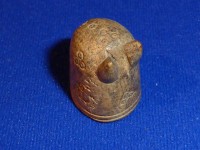 Archaeologists excavating the back yard of the Wallingford Museum on High Street in Wallingford, Oxfordshire, have unearthed a tiny medieval chess piece. At first museum curator thought it was a figurine of a cat, but once it was cleaned, they recognized the artifact as an Arabic chess piece carved from the tip of an antler.
Archaeologists excavating the back yard of the Wallingford Museum on High Street in Wallingford, Oxfordshire, have unearthed a tiny medieval chess piece. At first museum curator thought it was a figurine of a cat, but once it was cleaned, they recognized the artifact as an Arabic chess piece carved from the tip of an antler.
[Curator Judy Dewey] said: […] “It is one of only about 50 medieval chess pieces found in England and, at only 21.7mm high, it is unique in being the smallest medieval Arabic chess piece known in the country.
“The chess piece was made from the tip of an antler in the 12th or 13th century and is highly decorated with traditional roundels – most other such pieces are at least double the size.
This is a bishop so the other pieces in the set must have been really tiny – it may have been part of a travelling set.”
The museum’s main building was once Wallingford Priory, a Benedictine abbey that was suppressed by Cardinal Wolsey and of which only the foundations remain today, all of them underground. Wolsey secured a papal bull ordering the dissolution of Wallingford and 30 other small monasteries deemed to be rife with corruption. Funds raised from the dissolution would go to one of Wolsey’s pet projects: the construction of Cardinal College at the University of Oxford. The priory was surrendered in 1525 to notary John Allen, as witnessed by Thomas Cromwell, then Wolsey’s right hand man. It took three more years before the priory was finally suppressed for good. On July 6th, 1528, the monastery and its lands were formally transferred from the crown to Cardinal Wolsey for the construction of his college at Oxford.
Before the demise of the abbey, visitors to the castle of Wallingford were sometimes housed in the priory. Chess was deemed a game for the nobility and educated classes. Any one of those visitors might have owned a portable set, or the monks themselves may have played.
 Chess was introduced to Europe from Persia by the Islamic Arabian empire, likely through Spain. The Norman French brought it with them to England after the Conquest in the 11th century. Within a hundred years the original Arabic designs and names of the pieces were altered to forms more recognizable to the elite players of northern Europe. The Vizir became the Queen, the Fars (horse) became the Knight and the Al-Fil, the war elephant, became the Bishop. The look of the pieces shifted from the non-figural representation of the Islamic tradition to the people and characters we know today.
Chess was introduced to Europe from Persia by the Islamic Arabian empire, likely through Spain. The Norman French brought it with them to England after the Conquest in the 11th century. Within a hundred years the original Arabic designs and names of the pieces were altered to forms more recognizable to the elite players of northern Europe. The Vizir became the Queen, the Fars (horse) became the Knight and the Al-Fil, the war elephant, became the Bishop. The look of the pieces shifted from the non-figural representation of the Islamic tradition to the people and characters we know today.
The piece discovered at Wallingford is a war elephant, aka the future Bishop. The round protrusions represent tusks. To Christian European eyes those bumps were reminiscent of a bishop’s mitre, which is how the war elephant became a high-ranking clergyman. The piece likely dates to before the mid-12th century when the figural designs set in, increasing the game’s appeal and popularity across Christendom.
The chess piece is now on display at the Wallingford Museum. Digging is scheduled to resume this July, and archaeologists are crossing their fingers and toes that they might find more pieces from the set. It’s a long shot, however.